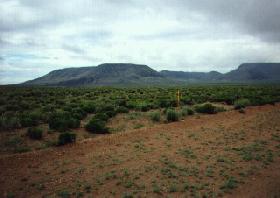Page Menu
More information can be found at the following links:

SLV Real Estate
 |
Rio Grande River Ranchos (above)
|
It has been said that there is somewhere around 40,000 subdivided and undeveloped lots in the Southern part of the San Luis Valley which typically range in size from 1/4 acre (which would require several to build on) to 5 acre parcels. You can see a sample of the subdivision road patterns on this link to Google Maps - Mesita, Colorado in Costilla County. Much of the land belongs to absentee land owners who have invested in Colorado real estate, often being from out of state and having never even seen their property. Often with such investments, taxes do not get paid on a timely basis (even though they are very low in this area) and the land ends up reverting back to the county ownership. Besides the incredible bargains you can find from private individuals, the counties can be another good resource if you have time to do the research and make the correspondence. With Colorado's economy and development running rampant in Denver, Colorado Springs, Fort Collins, Vail and even as far South as Grand Junction, it is only a matter of time until more developers discover the San Luis Valley like the huge Forbes Trinchera Ranch which you pass by on Colorado Highway 160 between Walsenburg and Alamosa. Surviving in the SLV would require water in the warm, dry high valley summers. It happens that under the San Luis Valley is perhaps the largest water resource in the state of Colorado, what has been described as a huge underground lake. Other parts of the state have been battling to try to tap this valuable resource and it has been the subject of much debate with many local government agencies. Well drilling is costly and your only other option would be hauling water from one the many small towns scattered across the SLV. If you do drill a well at a cost of around $5,000 or more, you will most likely have a very good one. The climate lends itself to alternative energy sources such as solar and the now readily available wind generators (they even have kits to build your own). Some developers are running in power, but self-sustaining homesteads are much more desirable and seem to be popular across the valley. This is one place in Colorado that the common man can still afford to build his dream (or you could consider Alaska). Over-regulation seems to be the trend in the front range area near Denver, but not so in the SLV. It requires so much to build in the Denver-metro counties that, unless you have extensive resources, you might as well forget it. In the SLV the "average joe" still can afford to do-it-himself. People are even using alternative construction methods such as tire homes, straw-bail homes and of course the classic adobe construction that has been used in the Southwest for many years. The soil there I am told is ideal for adobe as well. One home that really caught my attention is in the town of Antonito and appears as a statement to all who venture by. It looked rather old and reflected character which seems to have been lost in the huge and over-regulated metropolises ( see pictures ). It is nice to know that freedom is still alive and well in Colorado, and not all reserved to the privileged, with mega-bucks to spend on housing. If you are tough enough and love nature, this could be an option for year around living. As a summer vacation hide-away, the SLV is great. Some people park their campers on small lots and keep it as a peaceful place to escaped to from life in the big city. Perhaps we would have a lot less stress related problems in the cities if more people could find escapes such as this to restore inner peace. Fishing, camping, mountain biking, go-kart racing, ATV trail riding, river rafting (the Rio Grande runs through the SLV and one to Taos, New Mexico) and best of all, none of the crowds that have in recent years taken over everything in a 100 mile radius of Denver (Mesita, deep in the valley clocks about 230 miles from Denver via Interstate Highway 25 to Walsenburg, then West over La Veta pass on State Highway 160). |
